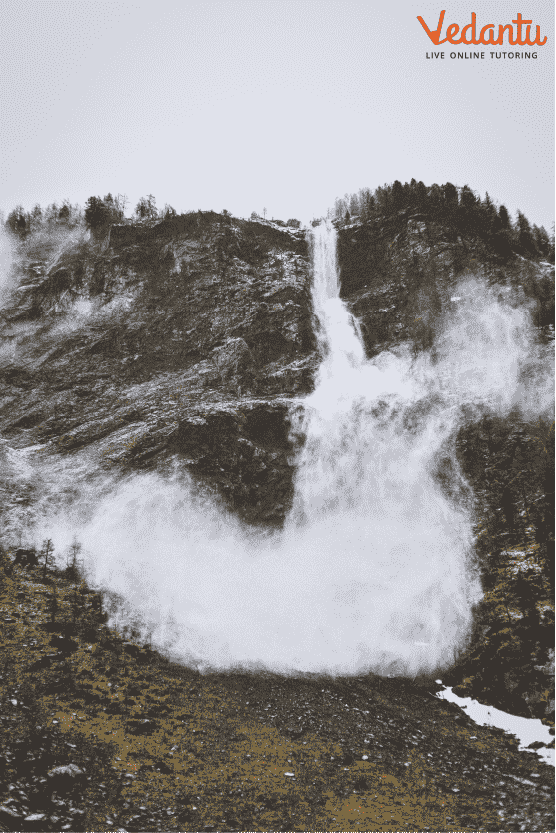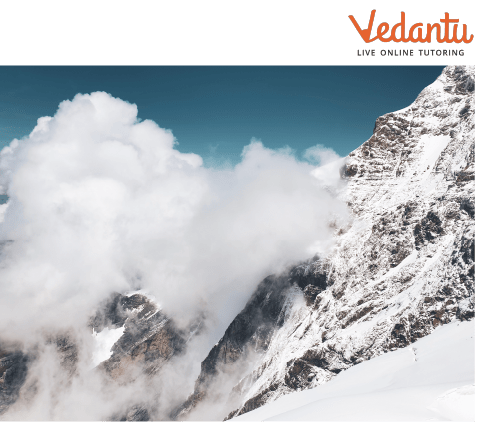




How Do Avalanches Happen? Key Concepts & Real-World Examples
An avalanche is a sudden snow flow down a slope, like a mountain or a hill. There are two avalanches. Slab avalanches, formed of closely packed snow, and loose snow avalanches, made of looser snow. Avalanches typically develop quickly after being triggered and increase in mass and volume as more snow is collected. A powder snow avalanche could emerge if an avalanche moves rapidly enough to mix part of the snow with the air.
Any mountain range with a prolonged snowpack has the potential to experience avalanches.
When a snowpack is loaded above its capacity, it will collapse. The weight of the snow is the load and hence causes the destruction.
Avalanches are among the most dangerous natural risks to life and property in mountainous places. Hence tremendous efforts are made to control them.

Avalanche
What are the Main Causes of Avalanches?
Wind Direction and Snowstorm: Avalanches are more likely to occur during heavy snowfall. Usually, wind travels across a mountain's slope from one side to the other.
Heavy Snowfall: The first is heavy snowfall because it deposits snow in vulnerable places and increases pressure on the snowpack. Wet snow avalanches are most commonly caused by summer rainfall.
Human Activity: In recent years, humans have triggered avalanches. The snowpack frequently cannot handle the pressure caused by winter activities that call for steep slopes.
Movement or Vibration: Using jet skis and all-terrain vehicles causes vibrations in the snow that it cannot sustain. It is one of the easiest ways to start an avalanche when combined with gravitational pull.
Snow Layers: In some situations, snow has already fallen and frozen onto the mountains. Fresh snow then covers the top, readily sliding down.
Warm Conditions: Warm conditions that continue for several hours each day might weaken some of the top snow layers and make them slide down.

Avalanche Caused by Warm Conditions
Interesting Facts about Avalanches
Over 150 people each year are killed by avalanches worldwide.
90% of the time, the victim or a member of the victim's group is to blame for the avalanche.
Because it is three times as dense as avalanche material, the human body sinks quickly.
It can move more quickly than 320 km per hour (200 miles per hour). Layers of snowpack begin to slip off, causing avalanches.
The 24 hours following a snowfall of at least 12 inches are when the avalanche risk is at its highest.
In contrast to direct snowfall, avalanches can develop due to wind-driven snowfall.
If saved in 18 minutes or fewer, the survival percentage of an avalanche victim is 91%.
Conclusion
A snow wave falling from a hill, hillside, or other sloped surface is an avalanche. Contrary to popular opinion, any snow formation placed on a slanted surface has the potential to produce an avalanche, given the correct circumstances. Hence an avalanche need not occur on a steep slope. Although avalanches can happen anytime, some places and seasons are riskier than others. In the mountainous areas of our globe, where the mountain tops are covered in several feet of snow, avalanches happen frequently.
FAQs on Essential Facts About Avalanches: Causes, Types, and Safety
1. What can be done to prevent avalanches?
To collect and balance the snow and prevent an eventual avalanche, build a tall fence on a mountainside. Use explosives to shake minor snow accumulations loose. This avoids greater quantities that might trigger powerful, devastating avalanches. Utilise big stones.
2. Can an avalanche be called a natural disaster?
An avalanche is a natural calamity when snow slides down a mountain quickly. A mixture of snow and ice (snowpack) is created during an avalanche. The avalanche starts when the snowpack along a mountain slope becomes unstable and starts to break off.
3. What consequences do avalanches have?
An avalanche can block any obstacle in its path. Railways and roads may be obstructed. Power sources may be turned off. A powerful avalanche has the potential to kill individuals as well as destroy buildings. Avalanches are caused by their victims 90% of the time.





















